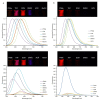Styryl-based new organic chromophores bearing free amino and azomethine groups: synthesis, photophysical, NLO, and thermal properties
- PMID: 33014168
- PMCID: PMC7509381
- DOI: 10.3762/bjoc.16.189
Styryl-based new organic chromophores bearing free amino and azomethine groups: synthesis, photophysical, NLO, and thermal properties
Abstract
Herein we report the synthesis and characterization of a new series of styryl-based push-pull dyes containing a free amino group and their Schiff base derivatives. The dyes include the dicyanomethylene group as an acceptor and different para-substituted alkylamines as donors. Morever as a proton-sensitive group a pyridin-2-yl substituent was attached to the para-position of the phenyl moiety in both series of compounds. The photophysical properties of the dyes were examined in various solvents with different polarities and showed absorption in the visible region and green-red emission with low quantum yields. The absorption and the emission maxima were shifted bathocromically by increasing the solvent's polarity. However, there was no correlation with the polarity parameters of the solvents. The pH-sensitive properties of all prepared Schiff bases were examined against TBAOH in DMSO, via deprotonation of the OH group in the salicylidene moiety and their reverse protonation was also investigated using TFA. The Schiff bases exhibited a bathochromic shift upon the addition of TBAOH to their solutions in DMSO. Therefore, they showed potential to be utilized as colorimetric and luminescence pH sensors. The second-order nonlinear optical (NLO) responses of the dyes were measured by the electric field-induced second harmonic (EFISH) generation method. The highest μβ values were obtained for the dyes bearing the julolidine donor as 1430 × 10-48 esu (for free amino derivative) and 1950 × 10-48 esu (for Schiff base derivative), respectively. The structural and electronic properties of the dyes as well as their NLO properties were further studied using DFT calculations. The thermal stabilities of all dyes were evaluated by thermogravimetric analysis (TGA). The TGA data showed that all dyes were thermally stable up to 250 °C.
Keywords: DFT calculations; NLO; Schiff base; pH sensitive dyes; solvent effect; styryl dyes.
Copyright © 2020, Putra et al.; licensee Beilstein-Institut.
Figures











Similar articles
-
Novel emissive styryl dyes from 9-methoxy anthracene: Synthesis, photophysical, thermal stability, viscosity, and DFT study.Spectrochim Acta A Mol Biomol Spectrosc. 2025 Jan 5;324:124952. doi: 10.1016/j.saa.2024.124952. Epub 2024 Aug 12. Spectrochim Acta A Mol Biomol Spectrosc. 2025. PMID: 39137708
-
BODIPY-bridged push-pull chromophores for nonlinear optical applications.Chemphyschem. 2014 Sep 15;15(13):2693-700. doi: 10.1002/cphc.201402123. Epub 2014 Jun 20. Chemphyschem. 2014. PMID: 24954812
-
Chlorine (Cl) - Substituted Carbazole Based A-π-D-π-a Push-Pull Chromophores as Aggregation Enhanced Emission (AEE) Active Viscosity Sensors: Synthesis, DFT and NLO Approach.J Fluoresc. 2019 May;29(3):779-795. doi: 10.1007/s10895-019-02396-y. Epub 2019 Jun 6. J Fluoresc. 2019. PMID: 31172327
-
Synthesis and Optical Characterization of Hydrazone-Substituted Push-Pull-Type NLOphores.J Org Chem. 2024 Sep 20;89(18):13192-13207. doi: 10.1021/acs.joc.4c01328. Epub 2024 Sep 10. J Org Chem. 2024. PMID: 39255504 Free PMC article.
-
Styryl Group, a Friend or Foe in Medicinal Chemistry.ChemMedChem. 2022 Apr 5;17(7):e202100706. doi: 10.1002/cmdc.202100706. Epub 2022 Mar 2. ChemMedChem. 2022. PMID: 35166041 Review.
Cited by
-
Influence of benzothiophene acceptor moieties on the non-linear optical properties of pyreno-based chromophores: first-principles DFT framework.RSC Adv. 2024 May 17;14(23):15964-15978. doi: 10.1039/d4ra00903g. eCollection 2024 May 15. RSC Adv. 2024. PMID: 38765473 Free PMC article.
-
Thermally activated delayed fluorescence (TADF) emitters: sensing and boosting spin-flipping by aggregation.Beilstein J Org Chem. 2022 Sep 8;18:1177-1187. doi: 10.3762/bjoc.18.122. eCollection 2022. Beilstein J Org Chem. 2022. PMID: 36128432 Free PMC article.
-
Carbamate-Functionalized NLOphores via a Formal [2+2] Cycloaddition-Retroelectrocyclization Strategy.Chemistry. 2025 Mar 3;31(13):e202404778. doi: 10.1002/chem.202404778. Epub 2025 Jan 31. Chemistry. 2025. PMID: 39844739 Free PMC article.
-
In silico screening of ethyl 4-[(E)-(2-hydroxy-4-methoxyphenyl)methyleneamino]benzoate and some of its derivatives for their NLO activities using DFT.R Soc Open Sci. 2023 Jan 11;10(1):220430. doi: 10.1098/rsos.220430. eCollection 2023 Jan. R Soc Open Sci. 2023. PMID: 36686549 Free PMC article.
-
Styrylpyridinium Derivatives for Fluorescent Cell Imaging.Pharmaceuticals (Basel). 2023 Sep 4;16(9):1245. doi: 10.3390/ph16091245. Pharmaceuticals (Basel). 2023. PMID: 37765053 Free PMC article.
References
-
- Valeur B, Berberan-Santos M N. Molecular Fluorescence: Principles and Applications. 2nd ed. Weinheim, Germany: Wiley-VCH; 2012. - DOI
-
- Gore M. Spectrophotometry and Spectrofluorimetry: A Practical Approach. Oxford, U.K.: Oxford University Press; 2000.
-
- Braslavsky S E. Pure Appl Chem. 2007;79:293–465. doi: 10.1351/pac200779030293. - DOI
-
- Williams D J. Angew Chem, Int Ed Engl. 1984;23:690–703. doi: 10.1002/anie.198406901. - DOI
-
- Boyd R W. Nonlineaer Optics. 2nd ed. San Diego, CA, USA: Academic Press; 2003. - DOI
LinkOut - more resources
Full Text Sources
